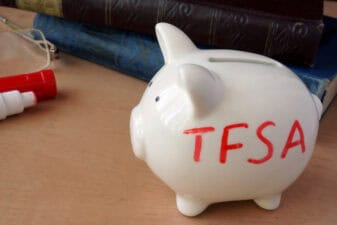If you’re retired, you need to protect your hard-earned savings. When you’re younger, you can afford to take financial risks. After all, you’re working and have a long time horizon. Once you’ve stopped working and get only pension income, you need to play it safe. RRSP money is money you need — not money you want. So, you need to take steps to lower the risk in your retirement investments. In this article, I’ll explore two ways to do just that.
Diversify with ETFs
If you’ve read anything about investing, you’ve probably heard about diversification. Basically, it means not putting all your eggs in one basket. By spreading your money out across several different investments, you reduce the risk of losing it all.
Unfortunately, building your own diversified portfolio isn’t as easy as it looks. Brokerages usually charge trading fees, and they could really eat into your returns if you’re spreading $100,000 across several hundred stocks.
Fortunately, you don’t have to build your own portfolio. With index ETFs, you can buy into a pre-built diversified portfolio of stocks. This reduces risk and spares you the trading fees that come with building your own diversified portfolio.
A good example of an index ETF is the iShares S&P/TSX Capped Composite Index Fund (TSX:XIC). This is an index fund built on the market-cap weighted holdings of the TSX — Canada’s largest stock exchange. With XIC, you immediately buy into a ready-made portfolio of hundreds of stocks. The TSX is heavily weighted in banks and utilities, giving it a nice amount of dividend income. At current prices, XIC yields a little over 3%. So, when you invest $100,000 in it, you get $3,000 and some change in dividends each year. Assuming, that is, no major dividend cuts occur. Which could happen. Hence the importance of getting some bond exposure in your portfolio.
Have a healthy proportion of your portfolio in fixed income
While diversification reduces the risk in holding individual stocks, stocks as a class are risky. So, as a retiree who needs to preserve capital, you should hold a portion of your portfolio in fixed income (e.g., bonds). Bond income is much more certain than dividends, because companies are legally obligated to pay their interest. Additionally, bondholders have a higher claim on assets in the event a company goes out of business.
Unfortunately, it’s hard to buy bonds directly. But you can get exposure through bond funds like the BMO Mid-Term U.S. Investment Grade Corporate Bond Index ETF (TSX:ZIC).
ZIC is a bond fund built on U.S. corporate bonds. Its yield is lower than a really high-yield dividend stock but higher than a GIC. According to BMO, the fund yields 3.4%. That’s pretty high for a bond fund. Some third-party data providers say the yield is closer to 2.9%, which is a fair bit lower. Regardless, you’ll get a return that likely beats inflation — but with way more safety than you’d get with stocks. It’s definitely a worthy investment for retirees to look into.








